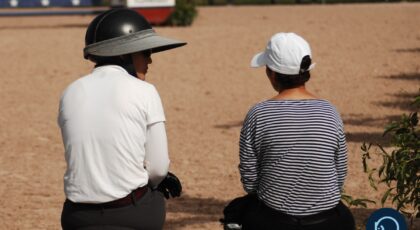You can leave your jacket behind and (this year) don a funky fedora. Friends become fierce competitors and cameras click as rider, trainer, and coach examine the array of obstacles set before them like so many sweets in a dessert buffet: some distinguished and elegant, some delightfully playful, some downright frightening. What matters more than the jumps themselves, though, are the distances between them. And as Susan Tinder writes in her book, Jump Course Design Manual, knowing the ins and outs of walking the in and out is your necessary passport to a clear round.
•••
Walking the Walk
Perfecting your course walk can go a long way to improving your performance. Walking and re-walking lines can help you cultivate an eye for finding the right takeoff spot.
Even before stepping foot on your course, practice walking in 3-foot (1-yard) increments. When you can consistently take 3-foot steps, it is relatively easy to determine a horse’s 12-foot stride. One horse stride is equal to four human steps (12 feet/4 yards).
1. You begin walking a line from the back of the first fence in the line. Your back and heels should touch the back of the first fence before you start striding and counting your 3-foot steps.

2. Walk forward and count the number of 3-foot steps it takes to reach the front of the next fence. Count your 3-foot steps in sets of four—ONE-2-3-4, TWO-2-3-4, THREE-2-3-4, FOUR-2-3-4, and so on—until you arrive at the base of the next jump. The number of strides in the line is one less than the total sets of four counted because you have to allow 6 feet for landing and 6 feet for takeoff (a total of 12 feet or one stride). For example, if you take 20 3-foot steps, the distance between the fences is 60 feet, or five strides, minus one for landing and takeoff—so a “normal” four-stride line.
3. Follow the track and proceed to the next fence, and the next, noting turns and related distances as you go.
Talking the Talk
What does the term “normal” mean when used in conjunction with a distance?
When the distance from one fence to another can be counted in a complete set of four, 3-foot steps, it is considered a “normal” distance because it correlates with a 12-foot stride.
When the distance is one step less than a complete set of four 3-foot steps, then the line is slightly “short” and shorter, steady strides are needed to ride it accurately.
When the distance is one step more than a complete set of four 3-foot steps, then the line is slightly “long” and more pace and forward motion is required.
When the distance is two steps off from a complete set of four 3-foot steps, it is on the “half-stride” and the rider must decide whether to extend the horse to ride a very forward line in the least number of strides, or to collect the horse, shorten his normal stride, and add an extra stride between fences.

It should be noted that for different horses, and due to various external factors, lines will ride differently. For example, ground conditions can influence distances to fences. Declines and inclines change the striding: a line sloping downhill will tend to ride slightly shorter than the same line from the opposite direction. Good footing tends to make distances ride “true,” while soft, deep footing or excessively hard footing may affect pace and stride length and make distances ride longer.
Walking the course allows you to pay attention to the footing on landings, takeoffs, and the condition of the tracks of rollbacks and tight turns. Pay particular attention to how multiple landings from many horses may affect the footing.
•••

This excerpt from Jump Course Design Manual, by Susan Tinder, was reprinted by permission from Trafalgar Square Books.

 June 3, 2016
June 3, 2016 

























